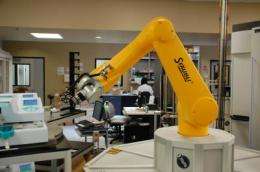Sanford-Burnham Medical Research Institute and Pfizer collaborate to speed drug discovery

Sanford-Burnham Medical Research Institute (Sanford-Burnham) is the latest research organization to partner with Pfizer, Inc. as part of Pfizer's commitment to transforming research and development through a focus on translational medicine. The Centers for Therapeutic Innovation (CTI) is a research unit at Pfizer dedicated to open innovation through establishing global partnerships with academic research institutions to bridge the gap between discovery science and clinical applications.
"Pfizer is truly excited to work in this new partnership with leading experts from Sanford-Burnham Medical Research Institute to understand more about the mechanisms that drive diseases with high unmet medical need," said Anthony Coyle, Ph.D., vice president and head of Pfizer's Global Centers for Therapeutic Innovation.
Using a combination of grant funding, philanthropy and strategic partnerships, Sanford-Burnham has built a sophisticated infrastructure for advanced drug discovery in the last few years, including recruiting industry-trained leadership with a track record of success in putting drugs into clinical development. Working with the Centers for Therapeutic Innovation (CTI) unit at Pfizer will provide Sanford-Burnham investigators with access to additional resources including select Pfizer compound libraries, proprietary screening methods, and antibody development technologies that are directly relevant to the investigators' work.
"The 'open innovation' model of the CTI is a perfect fit for Sanford-Burnham," said Sanford-Burnham CEO John Reed, M.D., Ph.D., professor and Donald Bren Chief Executive Chair. "The Institute's culture of collaboration is enhanced by the opportunity to work side by side with Pfizer researchers. Partnering with Pfizer accelerates our ability to translate our research more quickly into the development of biopharmaceutical products."
Centers for Therapeutic Innovation have been established by Pfizer in New York, Boston, San Francisco and San Diego, where the University of California, San Diego (UCSD) announced their participation in the CTI initiative in August 2011. Sanford-Burnham is one of only two participating institutions that are not academic medical centers. Given Sanford-Burnham's proximity to UCSD, it is anticipated that the Institute will collaborate with UCSD when a project reaches the clinical stage.
The CTI will provide funding to principal investigators for postdoctoral support (trainees within a laboratory who have recently completed doctoral studies), and provide technical support – including dedicated personnel – in addition to access to infrastructure encompassing laboratory space, chemical libraries, robots, etc. Financial details were not available, but the program has been described by Pfizer as being highly incentivized.
"Pfizer's CTI program represents a new model for early stage drug development," said Paul Laikind, Sanford-Burnham's Chief Business Officer, a seasoned entrepreneur and founder of three start-up companies that are now publically traded. "Aggressively working to close the gap between discovery research and clinical application benefits research, benefits patients, and ultimately adds to the innovation economy."
More information: beaker.sanfordburnham.org














